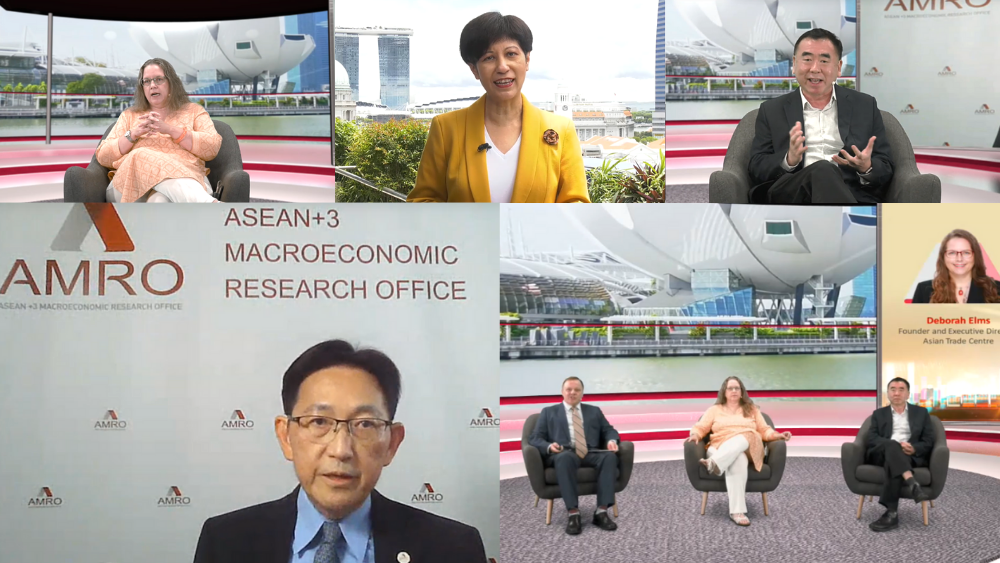
(Top row from L to R): Asian Trade Centre Founder and Executive Director Deborah Elms, Minister in the Prime Minister’s Office, Second Minister for Finance and National Development of Singapore Indranee Rajah, and Director, Policy Support Unit, Asia-Pacific Economic Cooperation Denis Hew
(Bottom row from L to R): AMRO Chief Economist Dr Hoe Ee Khor, Glenn van Zutphen, Deborah Elms, and Denis Hew
SINGAPORE, April 7, 2021 – The post-pandemic world calls for more globalization, not less. The pandemic exposed the vulnerabilities of global value chains (GVCs), as lockdowns around the world disrupted supply lines across economies. However, GVCs also helped meet the excess demand for medical supplies and other goods, and contributed to saving lives and speeding up the economic recovery globally and in the ASEAN+3 region. These points were underscored by speakers at the webinar, Global Value Chains in the Post-Pandemic “New Normal,” held today by the ASEAN+3 Macroeconomic Research Office (AMRO). The discussion was based on the thematic chapter of the ASEAN+3 Regional Economic Outlook (AREO) 2021, AMRO’s annual flagship report, launched last week.
Ms. Indranee Rajah, Minister in the Prime Minister’s Office and Second Minister for Finance and National Development of Singapore, delivered the opening remarks at the webinar. Dr. Hoe Ee Khor, AMRO Chief Economist, presented highlights of the AREO 2021 thematic chapter to set the context for discussion. He was joined by Ms. Deborah Elms, Founder and Executive Director of the Asian Trade Centre, and Dr. Denis Hew, Director of the Policy Support Unit at the Asia-Pacific Economic Cooperation, in a panel discussion on the reconfiguration of GVCs, tech tensions, and how the region could prepare itself to become more competitive and resilient in the post-pandemic environment.
“Although we have seen some cross-border relocation of GVCs globally, the ASEAN+3 region will remain a highly attractive location for GVC investment in the post-pandemic world,” said Dr. Khor. “The region’s middle class is expanding rapidly and becoming more affluent. The large pool of labor is upskilling to the digital economy. Businesses are adopting new technologies and creating more commercial opportunities.”
GVCs are an integral part of ASEAN+3 economies, taking up half of their regional and global trade volumes, and driving regional growth. Disruptions brought about by natural disasters, trade tensions, and the pandemic, have restarted a debate over future trade regimes and possible GVC reconfiguration, presenting the region with both challenges and opportunities. A China+1 strategy, where China remains the main supply and consumer node, but certain operations are relocated to its neighbors, will improve resilience and diversification. As long-term globalization benefits still outweigh short-term protectionism gains, the region should remain open to trade and investment, and demonstrate its collective commitment to multilateralization.
“GVCs have helped drive economic growth and development in Asia. In a post-pandemic world, they remain critically important,” noted Ms. Elms.
The panel also discussed how new digital technologies will transform production processes and reshape GVCs. The pandemic has accelerated digitalization for both businesses and customers, with technology-driven production and distribution activities as well as digital services now in place. As users become increasingly more comfortable with new technologies, the “flight to digital” has given the ASEAN+3 region a rare opportunity to upgrade and strengthen its role in GVCs. The region is in a unique position to not only champion greater openness, but also boost its competitiveness in the Fourth Industrial Revolution. The full deployment of new technologies will require continued investment in both hard and soft infrastructures to reap the full benefits.
“Although the trend toward digitalization predates the pandemic, digital solutions have now become a necessity rather than an option for many firms. The digitization of GVCs can improve risk management and reduce logistical bottlenecks,” observed Dr. Hew. “However, enhancing the resilience of these value chains requires a rethinking of policies such as those on data security and human capital management.”
Meanwhile, the clashes between global tech leaders may lead to a technology bifurcation that brings about short-term inefficiencies, posing risks to GVCs. Nevertheless, history shows that over time, such bifurcations can be mitigated and eventually resolved by developments in interface technology.
The panel concluded that to enhance the region’s competitiveness in the post–pandemic world, policymakers should focus on (1) building the enabling infrastructures to benefit from the Fourth Industrial Revolution; (2) securing sustainable funding to rebuild policy space and drive growth; and (3) strengthening global and regional frameworks to promote greater integration.
–
About AMRO
The ASEAN+3 Macroeconomic Research Office (AMRO) is an international organization established to contribute towards securing macroeconomic and financial stability of the ASEAN+3 region, which comprises the 10 members of the Association of Southeast Asian Nations (ASEAN) and China; Hong Kong, China; Japan; and Korea. AMRO’s mandate is to conduct macroeconomic surveillance, support the implementation of the regional financial arrangement, the Chiang Mai Initiative Multilateralisation (CMIM), and provide technical assistance to the members.
